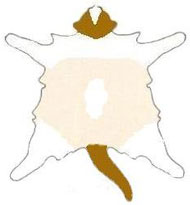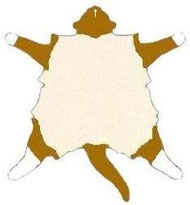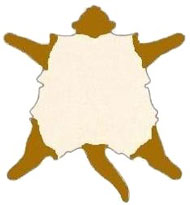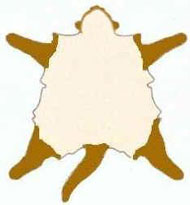The T.I.C.A. standard for the Ragdoll
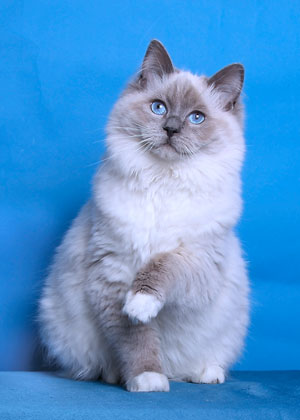 HEAD . . . . . . . . . . . . . . 40
HEAD . . . . . . . . . . . . . . 40Shape . . . . . . . . . . . . . . . 9
Ears . . . . . . . . . . . . . . . .. 5
Eyes .. . . . . . . . . . . . . . .. 7
Chin . . . . . . . . . . . . . . . . .5
Muzzle . . . . . . . . . . . . . . .4
Profile . . . . . . . . . . . . . . ..9
Neck . . . . . . . . . . . . . . .. .1
BODY . . . . . . . . . . . . . . .35
Torso . . . . . . . . . . . . . . . . 8
Legs/Feet . . . . . . . . . . . ...5
Tail . . . . . . . . . . . . . . . . ... 4
Boning . . . . . . . . . . . . . .. 10
Musculature . . . . . . . . . . ..8
COAT/COLOR/PATTERN . . . 25
Length . . . . . . . . . . . . ... . . 4
Texture . . . . . . . . . . . .... . . 8
Pattern . . . . . . . . . . . .. . .. . 6
Color . . . . . . . . . . . . . ... .. . 7
CATEGORY: Pointed.
DIVISIONS: Solid Point Division, Tortie Point Division, Tabby Point Division, Solid Point /white, Tortie Point/white, Tabby Point /white Divisions (mitted and bicolor pattern ONLY).
COLORS: All pointed colors.
PERMISSIBLE OUTCROSSES: None.
GENERAL DESCRIPTION:
The Ragdoll is a semi-long haired, blue eyed pointed cat with a sweet personality. The Ragdoll grows large and heavy, but is slow to mature and may not reach full weight and size for four years. Full color is not reached until 3 years old. The Ragdoll is muscular with little fat except on the lower abdomen fatty pad.
HEAD: Shape: Broad modified wedge, with slightly rounded contours, slightly rounded forehead (not domed), appearance of flat plane in area between ears, skull medium in size.
Ears: Medium in size, broad at base, rounded tip. Set as much on top of the head as on the side, slightly tiltedforward.
Eyes: Blue, large, oval, moderately wide-set, outer aperture to fall in line with base of ear.
Chin: Well-developed. Muzzle: Rounded, medium in length; in line with wedge.
Profile: Chin well-developed in line with nose. Straight nose to bridge followed by change of direction to gentle curve to brow. Appearance of flat plane between ears.
Neck: In proportion to head and torso.
BODY: Torso: Medium-long to long, substantial. Broad chest. Fat pad on lower abdomen acceptable. Females may be smaller than males.
Legs: Substantial boning, in proportion to body, hind legs slightly longer then front legs.
Feet: Large, round, tufting desirable.
Tail: Equal to length of body. Thicker at base, with slight taper.
Boning: Substantial.
Musculature: Well-muscled with solid weight.
COAT: Length: Semi-long, allow for shorter coats on unaltered adults and seasonal variations.
Texture: Silky soft, plush. Minimal undercoat gives the coat body but coat still falls smoothly. Not wooly or cottony
COLOR: Even, lighter color on the body with minimal shading. Definite contrast between body and point color. Allow for darker body color in older cats. Allow for undeveloped color in young cats.
SOLID POINT DIVISION: Points: Ears, mask, legs, feet and tail to be darker, well-defined color.
Body: Chest bib and chin areas may be somewhat lighter in color. Soft shadings of color are allowed.
ANY COLOR AND WHITE DIVISION:
Mitted Pattern:
Head: May have a broken or evenly matched white blaze on nose and/or between eyes. White not to extend into the inner corner of the eye, nose leather or whisker pads. Chin must be white.
Front feet: Evenly matched white mittens not to extend above bend of paw. All toes to be white.
Back Legs: White goes up to and around the hocks entirely and extends no higher than mid-thigh.
Body: White stripe extending from chin through chest and length of belly.
Bicolor Pattern:
Head: White inverted "V" on face that completely surrounds the pink nose leather and does not extend beyond the outer edge of the eye on either side. The "V" to be as symmetrical as possible. White Chin.
Body: Chest, stomach and ruff are white. Saddle may include white or shading in body color.
Feet and Legs: All white preferred. Small spots of point color allowable.
Paw Pads: Pink preferred, but mixture of color on paw pads acceptable because of two colors in pattern.
ALLOWANCES: Seasonal changes in coat length.
PENALIZE: General: Short tail, pointed ears, short legs; cobby body, round eyes,
Roman nose, straight profile, wooly/cottony coat texture.
Mitted: Lack of white belly stripe; white on ears and/or tail.
Bicolor: White beyond the outside edge of the eye. White on ears and/or tail. WITHHOLD ALL AWARDS (WW): General: Crossed eyes, any eye color other than blue. Pointed: Any white.
Mitted: Lack of white chin.
Bicolor: Any dark markings inside the white “V” including the chin.
Temperament must be unchallenging; any sign of definite challenge shall disqualify. The cat may exhibit fear, seek to flee, or generally complain aloud but may not threaten to harm. In accordance with Show Rules, ARTICLE SIXTEEN, the following shall be considered mandatory disqualifications: a cat that bites (216.9), a cat showing evidence of intent to deceive (216.10), adult whole male cats not having two descended testicles (216.11), cats with all or part of the tail missing , except as authorized by a Board approved standard (216.12.1), cats with more than five toes on each front foot and four toes on each back foot, unless proved the result of an injury or as authorized by a Board approved standard (216.12.2), visible or invisible tail faults if Board approved standard requires disqualification (216.12.4), crossed eyes if Board approved standard requires disqualification (216.12.5), total blindness (216.12.6), markedly smaller size, not in keeping with the breed (216.12.9), and depression of the sternum or unusually small diameter of the rib cage itself (216.12.11.1). See Show Rules, ARTICLE SIXTEEN for more comprehensive rules governing penalties and disqualifications.


